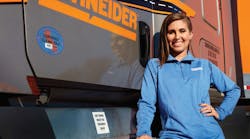Recruitment and retention strategies have been discussed at length over the years. But with the growing capacity challenges and increasing turnover rates, companies have had to think outside the box to bring talent to their operations—especially when it comes to recruiting women.
Wendy Greenland, CEO of Openforce, was joined by Jackie McManus, founder and CEO of KJ Media, Katie Love, marketing manager at Workhound, Tom Gennarelli, VP of trucking and transportation at Timber Products Company, and Nate Tellis, co-founder and CTO of RocketCDL, in a Women in Trucking Association (WIT) Accelerate! webinar to discuss best practices in retaining women in the workforce.
“The biggest thing we look at when we work with trucking companies is what’s beyond the black and white of the job description,” McManus explained. “What’s the overall culture of the company? It starts with leadership and trickles down to how recruiters talk to drivers. We find the first 60 seconds is when a driver connects or doesn’t connect with the recruiter. Will drivers feel valued at the company? It’s the gray area that makes the overall connection—not the black and white.”
Why do women leave?
RocketCDL's Tellis noted that people in the transportation industry are leaving for jobs that are more competitive. “Whether in regards to amenities in the office, time at home, benefits, transitioning to online operations, etc., companies have to stay competitive,” Tellis urged.
However, according to Love, pay or culture are not mutually exclusive.
“In our 2021 analysis, pay represents culture,” Love said. “How companies understand how pay works, how they communicate pay, helps show cultural norms on how the company works. Driver pay isn’t consistent, depending on the type of driver, so companies need to show their employees why they matter.”
Tellis stated that the top reasons women tend to leave are different from men, adding that women care more about safety, orientation prep, and recognition instead of more time at home, as many like to assume.
“New equipment matters to female drivers as newer equipment tends to be safer,” Tellis said. “Women like to feel like they are part of the company and part of the recruiting process, so being closer to operations helps retention, too. Female drivers are networked with other female drivers. And while people love cash advances for referrals, going beyond cash can be more personal, such as gift cards to retail stores, personalized gifts, etc.”
Pre- versus post-COVID
For almost everyone in trucking, life is permanently changed after the impacts of the COVID-19 pandemic. So, how is that impacting driver retention for women?
“We saw a distinct difference in how drivers talked about home time,” Love said. “Before, home time was important—now it’s critical. A deeper, more consistent stream of communication is needed. In 2020, truckers were called essential workers—that’s now a burnt-out term. In its place, there’s a deeper feeling of empathy where people are asking, 'How can I help?' and leaders are stepping up and getting it done.”
From the dispatcher perspective, Gennarelli reported that day-to-day operations have been very challenging over the last year and a half.
“Accommodating to the needs of dispatchers, regarding social distancing to protect themselves and family members while making sure that drivers are being taken care of has proven to be a challenge,” Gennarelli said. “Kudos to everyone out there making it work because it is not easy.”
According to Love, there’s a mental toll between drivers and dispatchers.
“With the stigma against mental health, where should drivers turn?” Love suggested. “Keeping communication lines open beyond when dispatchers need something or whenever something is wrong will help keep that relationship positive instead of negative.”
How to create the right culture
In the TP Logistics division at Timber Products, Gennarelli drives culture and safety. “Those two combined are critical in keeping women in the workforce,” he said. “To take care of that driver, look out for them, and make them feel part of the family—that’s critical. From panic buttons inside the cab to security cameras, etc. provide an extra level of safety. Because they feel safer, they want to perform for us.”
Even simple things like a washer and dryer. Someone recently asked Gennarelli why they can’t have a washer dryer in the driver room? “No one asked us that for 20-plus years, and now we’re putting one in,” he said. “Being honest on [internal] surveys tells companies exactly what drivers need.”
“At Workhound, we don’t provide demographics data because our work is anonymous,” Love explained. “For female drivers, what makes them stay seems to be a combo of intrinsic and extrinsic motivators. For example, having female restrooms and amenities help them feel represented.”
“Also, there’s a bit more autonomy for a 1099 worker,” Love explained. “Where I live in Chattanooga, Tennessee, 1099 workers are looking for more opportunities to keep money coming in whether it’s Uber or Lyft or even an Amazon fulfillment center that pays more and consistently.”
To Gennarelli, the three Rs when it comes to employees are retention, recruiting, and recognition. “Everyone has to own that—from management on down. Once you buy in, you are a part of the family. Open the door to communication. Being accessible for discussion helps women feel a part of something.
“We also offer great benefits,” Gennarelli added. “Our equipment turns over every four to five years, we have satellite TV in the cab as well as a microwave, and we allow pets of all kinds. Have a lizard? That lizard can go on the road. We also recognize birthdays, anniversaries, achievements, etc., as well.”
Recruiting the younger generation of women
“Social media is such a powerful tool,” McManus said. “By embracing the digital world, such as Facebook, where people are connecting with friends, family, coworkers, etc., you can reach so many more potential employees. Drivers tag their passive friends in digital ads to opportunities in trucking. If you have young female workers in your company, survey them to find out why they like working for you. Hearing it from them directly to build future recruiting strategies can allow you to create specific marketing collateral to each type of target audience.”
Tellis noted that drivers like to be able to envision themselves working at a company. If companies can use their drivers in their marketing collateral, they can help bridge that gap. “Tap into existing social networks,” he suggested. “Potential new employees are more willing to trust current employees more so than recruiters.”
According to McManus, TikTok has risen as a competitive network to reach drivers and females. “Facebook groups are really resourceful with the number of active members,” McManus added. “The forums, which can include thousands to hundreds of thousands of women, are inclusive and valuable to any recruitment process. Women like companies who do good things, so utilize social media to share stories of the good things that are happening in your company.
“Culture and inclusivity in the organization but also in the industry is vital,” McManus continued. “WIT is a great example of collecting all females in every aspect of the industry, from executives, drivers, technicians, etc. and bridging the gap. By having more conversations like these, now is the time to reach younger people to show them the inclusive culture of the industry to create and keep the next generation of truckers.”




